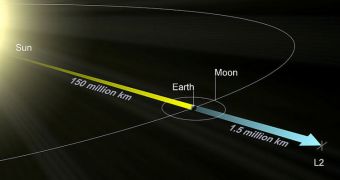Following 77 days of non-stop flight, the China National Space Administration's (CNSA) Chang'e 2 spacecraft is now parked in the L2 Lagrangian point. This spot is located about 1.5 million kilometers (932,000 miles) away from Earth.
Lagrangian points are locations around the Moon and Earth where an object always remains in the same relative position to the Earth-Sun-Moon system. The L2 point represents one of the most appealing locations for installing observatories such as the NASA James Webb Space Telescope.
CNSA also took advantage of this location, by sending its second space probe to the Lagrangian point after the spacecraft completed its mission in lunar orbit. The second stage of the flight is now oriented towards analyzing our planet's magnetic field, as well as the Sun.
In early 2011, the Chinese agency announced that Chang'e 2 completed its lunar mission, mapping the surface of Earth's natural satellite in detail. Once this stage of the flight was completed, CNSA mission controllers decided to guide the spacecraft to its new home.
The trip began in early June and ended in late August, making CNSA the third space agency in history ever to reach a Lagrangian point. Only NASA and the European Space Agency (ESA) managed to achieve similar performances with their respective spacecraft.
The China Daily newspaper reports that Chang'e 2 is now capable of observing our planet's magnetic field, as well as observe storms and coronal mass ejections (CME) occurring on the surface of the Sun.
At the same time, the spacecraft will act as a test bed for assessing the performances of two massive space communications antennas, which CNSA built recently, explains Liu Tongjie. He is the deputy director for the second-phase project of the China Lunar Exploration Program.
CNSA has an extremely ambitious space program, which includes conducting a manned lunar mission by the early 2020s, finishing its first space station about the same time, constructing a deep space antenna network by 2016 and conducting missions to the poles of the Sun and the gas giant Jupiter, Space reports.
The antennas Chang'e 2 is about to start analyzing are part of the deep space network. The first of them is located in northwestern China, and has a diameter of 35 meters (115 feet). The second one, boasting a diameter of 64 meters (210 feet), is being constructed in the northeastern parts of the country.
“It doesn’t take much energy for Chang'e to get to Earth-sun L2, and once you're there, it takes very little energy to go to other Lagrange points. So it actually makes a lot of sense for China to exercise its abilities in doing this,” University of Texas Department of Astronomy expert Dan Lester comments.

 14 DAY TRIAL //
14 DAY TRIAL //